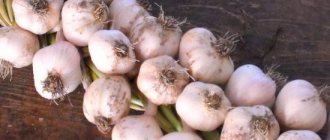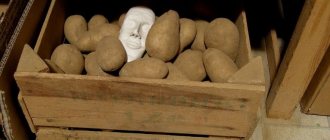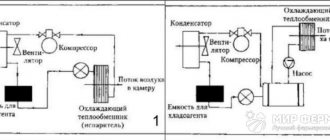Potatoes are actively used in cooking for preparing various dishes. To enjoy tasty and nutritious food throughout the year, it is important to know how to store potatoes in an apartment or cellar. The secrets to saving vegetables are quite simple - choosing the right variety, preparing tubers and creating favorable conditions. Following the recommendations presented in our article will help preserve potatoes until spring or a new harvest.
Proper organization of potato storage will allow you to preserve the tubers until the next harvest.
Potato harvesting, timing
A month before the potato tops dry out, the tubers become full and accumulate starch and other substances. The main thing is to harvest the potatoes on time.
When harvesting potatoes early
the skins have not yet had time to ripen and the potatoes will not overwinter well.
If you are late for harvesting potatoes
, tubers can become infected with rhizoctonia, or the fungal disease late blight. These diseases reduce the shelf life of potatoes.
Dig up potatoes in dry weather, leaving them to dry in the open air. Harvesting dates for early potato varieties
at the end of July, beginning of August.
Mid-season varieties
harvested in mid-August, late-ripening and
late varieties of potatoes
are harvested in late August, early September.
Therefore, try to harvest the potatoes within the specified time frame, otherwise in rainy weather the potatoes will absorb a lot of moisture and will hurt and rot. In dry weather, the tubers become soft.
When storing, try to store different varieties of potatoes separately.
Errors
An incorrectly selected variety will cause early spoilage of the tubers. For winter storage, only late-ripening varieties should be purchased. It is better if the selected variety is thick-skinned - this gives a better chance that the potatoes will last until the end of winter.
Buy only quality products. Saving on potatoes is fraught with negative consequences - all rotten and injured tubers will deteriorate, and they will provoke spoilage of a healthy product.
Rotting can also be caused by lack of air circulation. Therefore, the balcony must be opened slightly for a few minutes periodically. It is also better to store potatoes separately from other vegetables or only with beets. Other “neighbors” can negatively affect the keeping quality of the tuber and its taste.
By preparing a balcony for storing winter supplies of potatoes in advance, you can easily store them and provide your family with their favorite vegetable until spring. Moreover, there is nothing complicated about it.
If you find an error, please select a piece of text and press Ctrl+Enter.
The way vegetables are stored depends on their taste and shelf life. Can potatoes be stored in the refrigerator? It is believed that the refrigerator spoils the taste of potatoes and also affects the breakdown of starch.
To preserve the root crop, you need to follow certain rules.
Preparing tubers for storage
Cut off the tops 2 weeks before harvesting potatoes, this will help the tubers ripen better.
The dug up potatoes must be dried indoors (garage, barn, house) for 1-3 weeks.
If you dig in dry sunny weather, the potatoes will dry better in the sun, but no more than 2-4 hours, the potatoes may turn green. After that, be sure to dry it indoors, and then sort out the tubers.
Select rotten, green and damaged tubers separately; they are not suitable for long-term storage.
Always store damaged tubers separately from good ones.
Potatoes can be stored for a long time
medium size, well dried, without rot, cuts or flaws.
For medium storage
select the largest tubers.
For the smallest storage
Spoiled tubers are suitable.
Attention:
This is an important stage in preparing tubers for long-term storage, so do not regret low-quality potatoes, throw away less rotten potatoes in the spring.
We do not recommend putting sorted potatoes into storage immediately. For some time, the tubers ripen, breathe and heal the wounds.
Video - 5 mistakes when storing potatoes
Pros and cons of the method
The undoubted advantages of storing potatoes on the balcony:
- The availability of vegetables is one of the most popular ingredients in many dishes and is always at the hostess’s fingertips.
- Of all the places in a high-rise apartment, a balcony is the most optimal option for storing supplies. The premises are non-residential, containers with vegetables will not disturb anyone. And if you build a special design, then the potato storage can be given a very attractive appearance, and, with some effort, functionality (for example, by placing a soft pouf on top of the box, you can get an excellent place to sit).
- Minimum physical and time costs - no need to specifically go out to buy potatoes in the cold, or carry heavy bags in your hands.
- To create conditions for storing potatoes on a glazed balcony, you don’t have to make any special efforts. In such a room they are close to ideal - the temperature and humidity levels are close to those recommended for long-term storage.
There are also disadvantages:
- Low shelf life of tuber crops in an apartment compared to a cellar.
- Financial costs will still be incurred by those owners whose balcony is not glazed. To avoid stock freezing, you will have to buy or build a special box yourself.
- There will also be some troubles in the process of preparing for storage.
Storing potatoes in a cellar or basement
The best place to store potatoes is a cellar or basement
. This is a cool and dark room, always dry and clean. In summer, the basement is prepared for storage, whitewashed and ventilated.
Lime solution for whitewashing a cellar: 3 kg of lime per 10 liters of water, add 100 g of copper sulfate.
The optimal temperature for storing potatoes is maintained in the basement at 2-3 degrees and a humidity of 80%.
When the temperature deviates above 3-4 degrees, the potatoes begin to germinate; when the temperature drops below 0, the potatoes become sweet due to freezing.
It is best to store potatoes in wooden bins that allow air to pass through. Fill the bins to a height of 1 meter, cover with an old blanket or burlap.
It is also good to preserve potatoes in wooden or plastic boxes that are stacked on top of each other or on shelves. Boxes cannot be placed on the floor; they must be raised 20 cm from the floor.
Before storage, boxes are prepared:
repaired, cleaned, dried and disinfected with lime.
apples, mint, wormwood, and fern along with the tubers.
.
To absorb excess moisture, you can put straw or sawdust on the boxes.
During the entire storage period, it is necessary to sort through the potatoes 2-3 times, removing rotten, frozen and spoiled tubers.
Ventilate the basement from time to time; vegetables breathe and condensation may form on the walls. It is better to organize a ventilation pipe in the cellar; humidity has a bad effect on preserving the crop.
Video - Storing potatoes in the cellar
We monitor the quality of tubers
Potato agronomists believe that the quality of tubers has no less influence on the preservation of tubers than the variety.
Tubers to be stored must be:
- undamaged;
- clean;
- unsprouted;
- smooth, approximately identical in shape;
- ripe, with thick skin.
Mihkel
The easiest way to tell if a potato is ripe is to rub the skin with your fingertip. If the skin peels off (flakes), the potato is not yet ripe. If it stays tight, that's it.
You can help potatoes grow skin if you mow the tops 5-7 days before digging. The tops are mowed, leaving stumps 15 cm high.
Under no circumstances should tubers affected by phytophotora, as well as any type of rot, be sent for storage. Be careful not to put a frozen tuber in the basement along with the rest of the potatoes - it reduces the keeping quality of the entire crop.
Not only the type of potatoes is important, but also the smell: if pesticides were used during cultivation, and the tubers smell somehow strange, they cannot be stored.
Before storage, the tubers must develop a strong, durable skin. The fact is that microorganisms will not penetrate tubers with intact, strong, undamaged tissues. All micro-wounds of the tuber heal if the dug potatoes are kept for two to three weeks at +12 - +18°C and air humidity 90 - 95%. This period is called the healing period.
Potato storage pit
If you have harvested a large crop of potatoes and they do not fit in the cellar, you can store the potatoes in a specially made hole.
To construct a pit, choose a place located away from groundwater, with dense and dry soil. Dig a hole 1.5 m deep and 2 m wide. Special gutters are made to drain rainwater.
Straw is placed at the bottom of the pit, potatoes are poured in, leaving a space of 0.5-0.7 m to the top. Cover the top with straw 10 cm thick and place dry boards on the pit. The earth is poured onto the boards in several stages.
How to store potatoes in an apartment
Storage in an apartment involves choosing a place where the potatoes will be most comfortable. There are 3 places:
- In the entrance or storage room . The entrance or pantry is cool and vegetables are always at hand, but there is a drawback: depending on the time of year, different t modes are maintained.
- On the balcony . Tubers feel comfortable on the balcony if the t regime is observed. The main thing is to place wooden boxes so that there are no gaps between them; they need insulation.
- In a refrigerator . t not lower than 3C. Store potatoes for no more than 2 weeks.
How to store potatoes on the balcony?
In apartments, potatoes can be stored on the balcony. If the balcony is glazed, simply cover the boxes or bags of potatoes with blankets. But this is enough for temperatures down to -10 degrees.
To better preserve the harvest, it is better to build a storage facility from thick plywood or boards. This box is lined with plastic or painted so that it does not allow moisture to pass through.
The box must be equipped with a double bottom or double lid. Fill the void with insulation - polystyrene foam or sawdust. It is advisable to also insulate the sides of the box.
You can use an old refrigerator as storage by turning it upside down. Such storage will withstand frost down to -20 degrees.
If there is no balcony in the apartment, potatoes are stored in a dark place. The shelf life of such potatoes is reduced to 1 month, the tubers begin to sprout and become sluggish and soft.
Video - Box for storing vegetables on the balcony
How to prepare a cellar
The optimal constant temperature is 2-4°C. Constant humidity is also extremely important - 80-90% - as well as protection from water ingress.
The cleanliness of the cellar is of great importance, so it is pre-treated.
Treatment
All unnecessary things are thrown out of the cellar, garbage is removed, and the floor is swept. The shelves on which the boxes of potatoes will be stored are taken out into the sun and dried. They are then treated with antifungal drugs. The walls and ceiling are inspected for the presence of mouse and rat passages; if there are any, they are filled with cement. After this, the walls and ceiling are treated with lime.
After all these steps, the cellar is left open to dry for 3-4 days.
Preparing the storage container
If potatoes are stored in wooden boxes or pallets, they are inspected for damage and replaced with new ones if necessary. Then the boxes are cleaned of soil and other contaminants and washed with soapy water. After this they are dried in the sun.
Storing seed potatoes
For sowing, gardeners select and store seed potatoes. It is important to save these potatoes until spring. Select medium-sized, unspoiled, ripe tubers for planting.
Be sure to dry the tubers well and store at a temperature of 2-3 degrees. A month before planting, the temperature is gradually increased.
Storage conditions: at what temperature can vegetables be stored, at what degrees does it freeze
The best option is a glazed loggia or balcony, where the storage temperature is optimal - it stays at +2...+6 ° C, and the humidity level is about 40-45%. The tubers will be able to tolerate minor fluctuations (0...+10 °C), but on the condition that such deviations will be short-lived.
If the thermometer drops below the specified mark, the potatoes will freeze and begin to rot. Too high a temperature contributes to the withering and drying out of tubers, their germination and deterioration in the taste of the product. Excessive humidity will provoke the development of putrefactive processes, and then the potatoes will not be able to be preserved until spring.
Otherwise, the vegetable may acquire a greenish color, which indicates the accumulation of the harmful substance solanine in it. These potatoes are not suitable for human consumption.
Potatoes turn black during storage, what should I do?
If the rules of cultivation and storage are violated, the potatoes turn black inside.
This happens when there is excess nitrogen in the soil; when applying fresh manure to the soil, harvesting is not on time, poor preparation of tubers for storage.
Potatoes do not like the application of fresh organic fertilizers and are susceptible to fungal diseases when there is excess nitrogen. During the period of tuber formation, potatoes must be watered.
Often untimely harvesting leads to darkening of potatoes. Before storing, be sure to dry and cool the potatoes, otherwise they will quickly spoil.
How to protect root vegetables from freezing
It’s not a difficult task to face the fact that potatoes are frozen on the balcony. Here are some tips that can protect it from freezing:
- Tubers sent for storage must be dry. Wet potatoes freeze much faster.
- Untimely insulation of the storage is the reason for freezing of tubers. Often, owners rush to cover supplies only when the temperature has already dropped sufficiently. In such a situation, the potato has time to get the first frostbite, and subsequent actions will no longer bring the desired effect.
- Potatoes left on the balcony are not covered, which causes the top layer to freeze. Be sure to cover the storage container with a lid or, in extreme cases, with insulation (cotton blanket, mattress).
Diseases and causes of their occurrence
If stored improperly, potatoes can be affected by diseases:
- late blight . Hard spots appear on the tubers, which damage the pulp. Appears if one of the fruits has already been infected;
- dry rot . A white moldy coating appears on the peel. Occurs if the tubers have been moistened and is transmitted with adhering soil. It is recommended to wash potatoes before storing;
- black scab . A fungus that attacks the pulp of a tuber. It is also transmitted through the soil; if the temperature is incorrect, it quickly spreads to other potatoes;
- freezing potatoes . Occurs if the vegetable is stored at temperatures below 2C.
When harvesting, you need to be careful and carefully sort through the root crops.
Dry rot on tubers
Choice by appearance
You can also choose potatoes for storage in a store, but most purchases take place at agricultural markets, where the assortment is usually much richer. And first of all, of course, the appearance of the proposed product catches the eye. As has already been established, large potatoes are sold much more expensive than small ones. The first one is easy to clean, and the second one can be bought by those who have a rather acute financial issue.
But nutritionists are still arguing about which of them is the most useful. Some argue that medium and small potatoes contain fewer nitrates and more nutrients, while large ones contain a lot of chemicals. The latter advise choosing large tubers, since they are fully ripe and have acquired a sufficient amount of vitamins.
But whatever your choice, you should not buy potatoes with peeling skin. This is a sign of immaturity, and therefore short storage. Ripe potatoes have smooth, thick skin, without signs of peeling.
If the question is about which potatoes are best to buy for the winter, then you should choose the one that grew in sandy soil. Starchy, aromatic and crumbly, it will be a welcome guest on every table. But potatoes grown on peat bogs are worse in taste and keeping quality.
What varieties of potatoes are best stored in winter?
All potatoes are stored, but the shelf life of potatoes varies. Late and mid-late potato varieties are best preserved in winter. They are best stored in storage.
But you don’t always need to rely on the labels of elite potato varieties for storage. Local zoned potatoes are time-tested. If it has positive reviews from gardeners about taste, yield and shelf life, then you should give preference to this particular variety.
Experienced summer residents advise planting several varieties of different ripening periods. Then, no matter the weather and conditions of care, you will not be left without a harvest.











